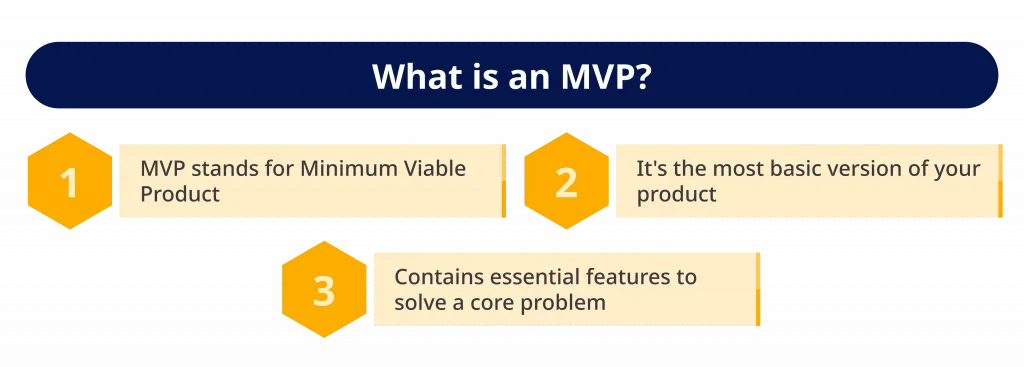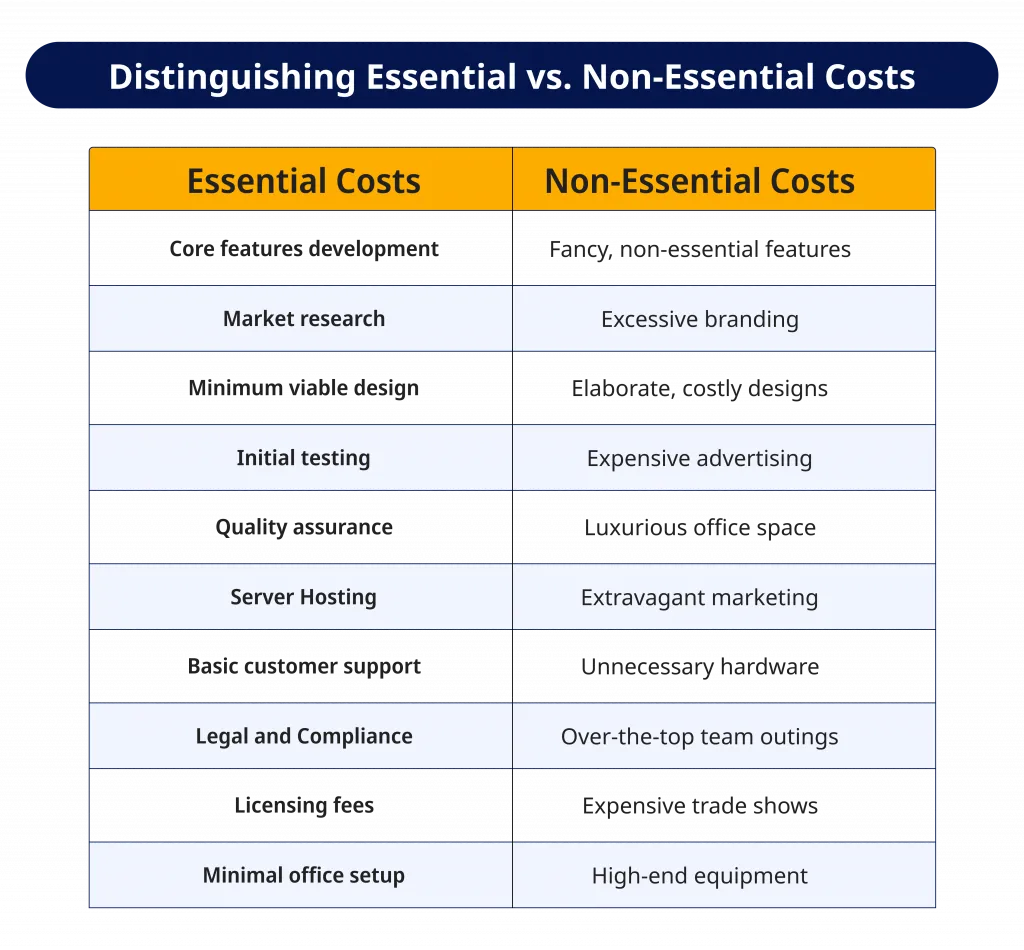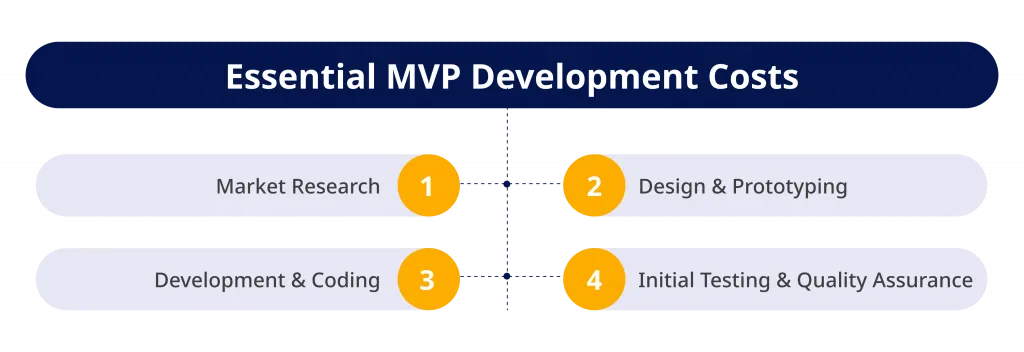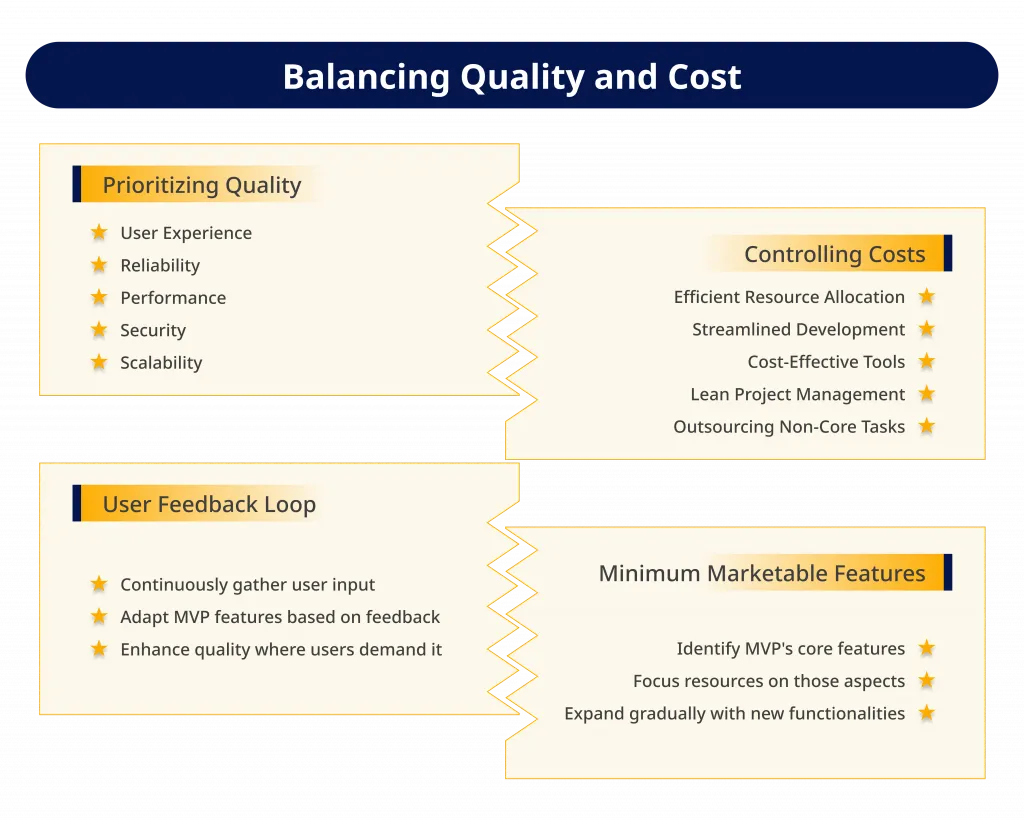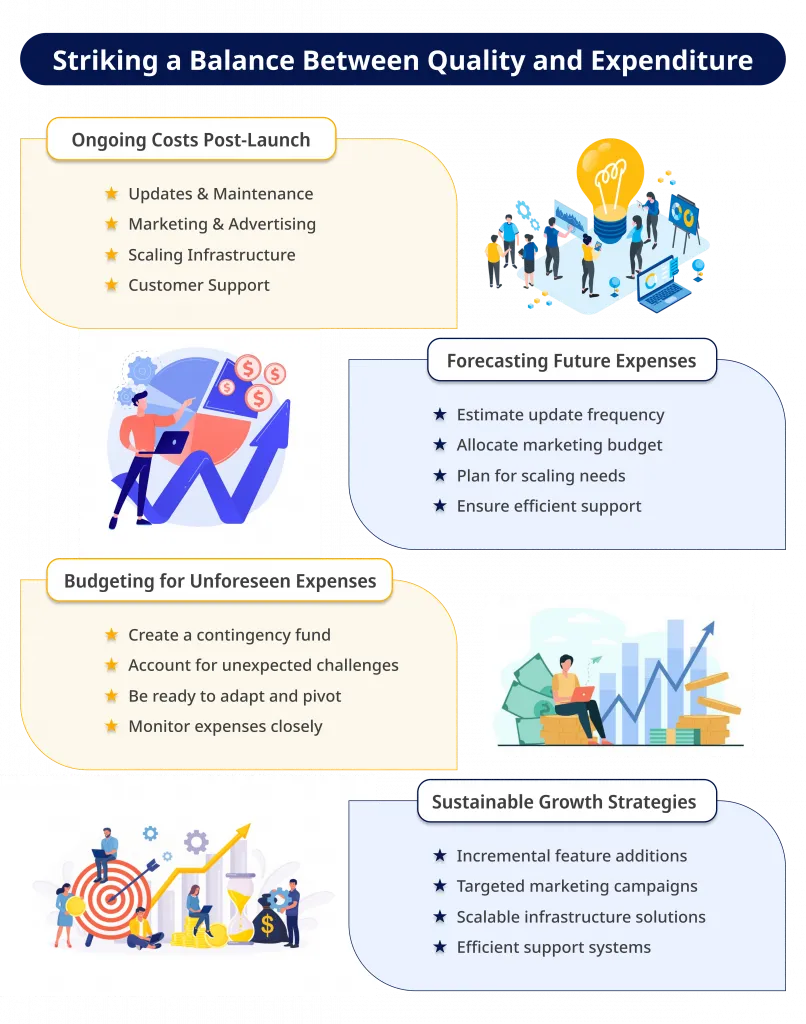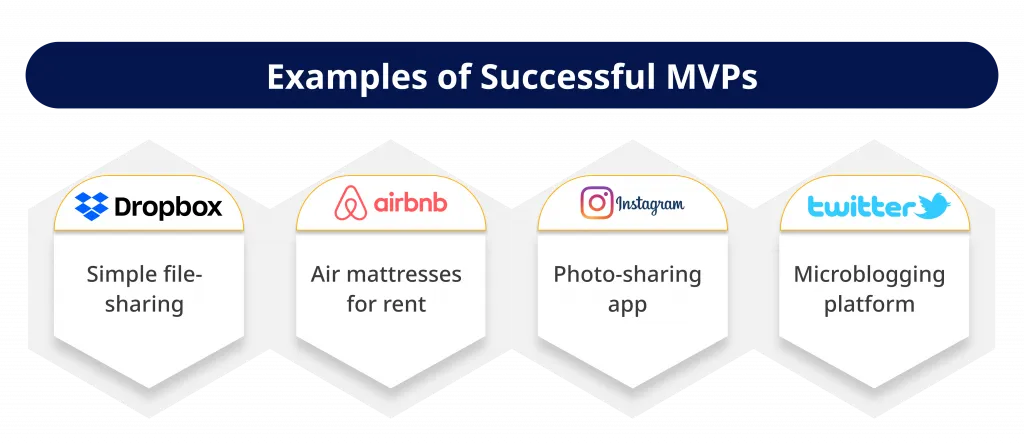Starting a new business? Wondering how much it will cost to build your Minimum Viable Product (MVP)?
Developing an MVP on a budget can seem daunting, but it is possible with some planning and knowledge of what to expect.
Building an MVP is a key first step for any startup – it allows you to test your product idea quickly and start gathering feedback from real users.
But how much should you plan to spend?
While costs can vary widely based on features and complexity, the median budget for an MVP is roughly around $15,000.
Apps with more complex functionality like payment integration or data analytics may require larger budgets, approximately $40,000 to $100,000.
The key is allocating your MVP budget wisely to focus on your core features and prioritize app development costs.
While defining an exact MVP budget can be challenging, thoroughly evaluating these factors will get you to a realistic estimate. And remember, your goal is not perfection but rather learning as much as possible from initial customers.
This blog post will guide you on how to do some thoughtful budget planning for your MVP. In this, we’ll discuss some key points like factors to consider, useful tips along some common pitfalls to consider while planning your MVP.
Discover how ValueCoders can supercharge your MVP Cost Planning strategies.
Understanding MVP Development
MVP development, which stands for Minimum Viable Product, is an important phase in the process from an idea to a successful product. It’s like building the foundation of your project – you want it to be strong and efficient yet cost-effective.
Let’s understand the essentials with clarity and simplicity.
- Anticipated Expenses for MVP
Before you begin MVP development, estimating your expenses is crucial. Think about development costs, marketing efforts, testing, and potential unexpected hiccups. Creating a realistic budget is the first step toward a successful MVP.
- Budgeting Strategies for MVP
Your MVP budget should align with your project’s objectives. Seek advice or consultation from companies offering eCommerce Consulting Services to ensure accurate budgeting. Keep an eye on your budget as your project evolves, adjusting it as necessary.
- From MVP to Full-Fledged Product
Understand that your MVP is not the end but the beginning. Plan how you’ll transition from a basic MVP to a feature-rich product. Consider scaling, adding more features, and incorporating user feedback.
- Custom Software Development Challenges
In custom software development, challenges are part of the journey. Address these challenges with a well-defined strategy. Continuously adapt and refine your approach to overcome hurdles effectively.
- MVP in Software Development
MVP is a cornerstone of software development. It’s about delivering the core value to your users quickly. It helps validate your idea, gather user insights, and attract early adopters.
MVP development involves estimating costs, budgeting smartly, planning for growth, tackling challenges, and focusing on delivering value.
It’s the strategic launchpad for your product, and by understanding these key elements, you’re better equipped to steer your project toward success.
Also Read: Benefits Of MVP Development Approach In Product Development
The Importance of Budgeting
Creating an MVP on a budget is indeed crucial, but it’s not just about penny-pinching; it’s about smart and strategic budgeting.
When planning your MVP budget, it’s imperative to consider these key points:
1. MVP Cost Planning: Begin your MVP journey by meticulously planning your costs. Determine the financial scope of your project and establish boundaries. Effective cost planning ensures you allocate resources judiciously, preventing financial surprises.
2. Budgeting Strategies for MVP: Embrace a strategic approach when crafting your MVP budget. Align your budgeting strategies with your project’s objectives. Ensure every dollar spent directly contributes to your MVP’s success.
3. MVP Development Cost Estimation: Accurate estimation of MVP development costs is paramount. Break down your expenses, including development, testing, marketing, and potential contingencies. Precise cost estimation empowers you to budget wisely and make informed financial decisions.
Budgeting for an MVP is more than just financial planning; it’s about making thoughtful and strategic decisions. Any company offering Product Consulting services can assist you with budgeting
These budgeting strategies and cost-planning considerations ensure you build something customers want without draining your resources in the early development phases.
By incorporating these practices, you’ll maximize learning, minimize risks, and set your MVP on the path to success in custom software development.
Learn how our expertise in MVP Development services can maximize your ROI while minimizing costs.
Factors to Consider When Budgeting for Your MVP
Developing an accurate budget for your Minimum Viable Product (MVP) requires thoughtful planning and analysis. When estimating your MVP costs, be sure to evaluate these key factors:
1. Core feature set: Resist the temptation to build out every possible feature in your initial launch. Carefully identify the absolute minimum set of features that will validate your hypothesis with early adopters. After you’ve proven product-market fit, additional features can be added in later iterations. Focusing on a narrow feature set first will help control development costs.
2. Development team size: More developers working in parallel will speed up build time but increase costs. Consider starting with a small, nimble team of 1-3 developers to keep costs down initially. Ramp up as needed after launch.
3. Technical complexity: Simple, streamlined technologies will require less development effort than complex stacks. Prioritize simplicity, especially in your MVP. Complex tech can come later.
4. Design complexity: Highly customized designs are more expensive than simple, clean UI/UX. Start simple. Seek a company offering UI/UX Design Services like ValueCoders to avoid design complexiities.
5. Location: Development costs vary widely across different regions. Take time to research affordable talent globally.
6. Development methodology: Waterfall development is high-risk for early-stage products. Agile methods add flexibility to pivot quickly based on user feedback.
7. In-house vs outsourced: In-house development adds overhead but tighter control. Outsourced consulting offers flexibility but less oversight. Evaluate the tradeoffs.
Taking the time to thoroughly evaluate these key factors will give you the insights needed to build an accurate MVP budget.
Remember, the goal of your MVP is to maximize learnings, not deliver a perfect product. Careful planning and budgeting will help you achieve that goal without overspending.
Discover how our services can help you cut expenses while building a successful MVP.
Budget Allocation
Allocating your budget effectively is a crucial aspect of financial planning, especially for projects like Enterprise Software Development Services, where MVP Cost Planning plays a significant role.
Here are some tips to help you allocate your budget wisely, including considerations for Minimum Viable Product Budget and Planning for MMVP Budget Expectations:
- Prioritize Expenses: Start by identifying your essential expenses. These non-negotiables must be covered, such as employee salaries, software development costs, and MVP Budgeting.
- Categorize Costs: Break down your budget into categories that align with your project’s objectives. For instance, allocate funds for software development, marketing, research, and development, all while considering a Minimum Viable Product Budget.
- Set Aside Contingency: Always reserve a portion of your budget for unexpected costs or emergencies, especially in projects like Enterprise Software Development Services.
- Allocate for MVP Development: Ensure that a significant portion of your budget goes towards MVP development if it’s a core part of your project. This includes resources, tools, and talent necessary for MVP Cost Planning.
- Consider Long-Term Goals: Think about your project’s long-term sustainability. Allocate resources to areas contributing to its growth over time, factoring in Financial Planning for MVP.
- Monitor and Adjust: Regularly review your budget to track how funds are being used. Adjust as needed to stay on course, particularly regarding the Minimum Viable Product Budget.
- Invest Wisely: If possible, allocate some funds for investments that can generate returns to support your project’s growth.
- Seek Expert Advice: For complex projects or when planning for MMVP Budget Expectations, consider consulting financial experts who specialize in your industry.
Remember that budget allocation isn’t static; it’s a dynamic process that should evolve as your project progresses.
By carefully considering these factors and staying flexible, you can effectively allocate your budget to support your Enterprise Software Development Services project while keeping an eye on MVP Cost Planning and other financial aspects.
Learn how our MVP Cost Planning expertise can propel your project to success.
Planning for Contingencies
Planning for contingencies is vital to any project, including those involving MVP Development Services and MVP Budgeting. Contingencies are like safety nets that help you prepare for the unexpected hurdles and keep your project on track.
Here’s a simple guide on how to effectively plan for contingencies:
1. Identify Potential Risks: Start by listing potential risks or challenges that could arise during your MVP Development Services project. These could be technical issues, delays in delivery, or unexpected resource constraints.
2. Assess Impact: Evaluate the potential impact of each risk on your project. Consider how it might affect timelines, costs, and the overall success of your MVP Budgeting. If required, get in touch with a company offering Startup Product Development Services who can guide you in this.
3. Allocate Resources: Set aside a portion of your budget and resources to address these contingencies. This reserve should be sufficient to cover the impact of the identified risks.
4. Create a Contingency Plan: Develop a clear plan for how you will respond to each identified risk if it materializes. This plan should outline specific actions to mitigate the impact and get your project back on track.
5. Monitor Continuously: Keep a close eye on your project’s progress and be vigilant for any signs of potential risks becoming a reality. Regular monitoring can help you detect issues early and implement your contingency plan proactively.
6. Adjust as Needed: If a contingency plan needs to be activated, be prepared to make adjustments in terms of budget, resources, and timelines to address the issue effectively.
7. Communicate Transparently: Maintain open communication with your team and stakeholders about the contingencies and their potential impact on the project. Transparency can help build trust and support during challenging times.
8. Learn and Improve: After the project is completed, review how well your contingency planning worked. Use this feedback to enhance your approach for future MVP Development Services endeavors.
Remember, while it’s impossible to predict every challenge that may arise, a well-thought-out contingency plan can significantly increase your project’s resilience and chances of success.
By allocating resources and having a clear strategy, you can confidently navigate unexpected twists and turns in your MVP Budgeting project.
Also Read: POC, MVP, Or Prototype: Decoding The Ideal Launchpad For Your Business Triumph
Common Pitfalls to Avoid
When comes to software software development, particularly when dealing with POCs, MVPs, and Prototypes, can be tricky. To ensure your project’s success and effective MVP Cost Planning, it’s crucial to steer clear of common pitfalls. Let’s explore these pitfalls and how to avoid them:
1. Unclear Objectives
- Pitfall: Starting a project without a clear understanding of its purpose and goals.
- Solution: Define the objectives of your POC, MVP, or Prototype before diving in. Be specific about what you want to achieve with Software Outsourcing Services.
2. Scope Creep
- Pitfall: Allowing the project scope to expand uncontrollably, leading to delays and increased costs.
- Solution: Clearly define the scope from the outset and stick to it. Any changes should be carefully evaluated for their impact on MVP Cost Planning.
3. Neglecting User Feedback
- Pitfall: Ignoring user feedback during the development process.
- Solution: Actively gather and incorporate user feedback into your POC, MVP, or Prototype. This ensures your software meets user needs effectively.
4. Rushing Development
- Pitfall: Trying to rush through development without adequate planning.
- Solution: Take the time to plan properly, including MVP Cost Planning, before starting development. Rushing can lead to costly mistakes.
5. Overcomplicating
- Pitfall: Overloading your software with unnecessary features and complexities.
- Solution: Keep it simple and focus on essential functionalities. Complexity can hinder progress and increase development time.
6. Lack of Testing
- Pitfall: Neglecting thorough testing of your software.
- Solution: Test rigorously to identify and rectify issues early on. Testing is essential for successful POCs, MVPs, and Prototypes.
7. Poor Communication
- Pitfall: Inadequate communication among team members and stakeholders.
- Solution: Establish clear communication channels and ensure everyone is on the same page regarding MVP Cost Planning and project progress.
8. Unrealistic Expectations
- Pitfall: Expecting your POC, MVP, or Prototype to be a fully polished product.
- Solution: Understand that these are stepping stones. Manage expectations and communicate the purpose clearly.
By avoiding these common pitfalls, you can enhance your software development journey, optimize MVP Cost Planning, and ensure your POCs, MVPs, and Prototypes serve as valuable stepping stones toward successful Software Outsourcing Services.
Clear objectives, effective communication, and a focus on user feedback are key to avoiding these pitfalls and achieving your development goals.
Also Read: From MVP To Full-Fledged Product: A Complete Guide
Monitoring and Adjusting Your Budget
Successfully launching and iterating an MVP requires diligent budget oversight from start to finish. Carefully monitor your actual spending compared to estimates and make adjustments as needed.
1. Work Closely With Your Team: During development, work closely with your team to keep projects on budget.
2. Review Progress: Review progress regularly and watch for scope creep that may inflate costs. If certain features start to look more expensive than planned, consider descoping or deferring them. Making small course corrections during the build process is easier than major cuts late in the game.
3. Track Hourly Billing: Track hourly billing from outsourced teams closely for inefficiencies. If costs start trending higher than expected, address it immediately to avoid a nasty surprise down the road.
4. Onboard Experts: Consider bringing on an experienced project manager to monitor spending and team productivity if needed.
5. Keep a Close Eye on Contingency Funds: As you get closer to launch, keep a close eye on contingency funds and tap into them conservatively. Try to avoid letting your core features consume contingency money. Those funds are better reserved for unexpected emergencies.
6. Consider User Feedback: Post-launch, iterate carefully based on user feedback.
7. Stick to MVP Principles: Add features strategically, not simply because they are requested. Stick to your MVP principles; only build what is needed to support key learnings at each phase.
8. Monitor Closely: Monitor closely for low-value features that don’t align with your hypotheses; these are areas to cut.
Ongoing monitoring provides the data needed to adjust your budget over time. Being disciplined about aligning spending with your MVP goals will allow you to further invest in the features that show traction while phasing out those that do not.
With careful management of your MVP budget, each iteration will move you closer to product-market fit. You can also Hire MVP Software Developers who can guide you in efficiently adjusting your budge.
See how our MVP Development Services can turn your vision into reality.
Real-World Case Studies
Examining real-world case studies is a fantastic way to gain insights into the practical application of MVP Cost Planning.
These examples showcase how businesses have successfully used Minimum Viable Product (MVP) strategies to manage their costs while achieving their goals. Let’s explore a couple of such cases:
1. Airbnb
- Challenge: Airbnb initially faced the challenge of attracting both hosts and guests to their platform, all while managing MVP Cost Planning.
- Solution: They created a basic website with minimal features to test their concept. This MVP allowed them to validate the idea without massive development expenses.
- Outcome: Airbnb’s MVP was a success, leading to gradual expansion and feature enhancements as they gained traction. This cost-effective approach played a significant role in their growth.
2. Dropbox
- Challenge: Dropbox wanted to offer cloud storage solutions in a competitive market without overcommitting resources.
- Solution: They launched a simple MVP that allowed users to upload and share files, focusing on the core functionality while keeping MVP Cost Planning in check.
- Outcome: Dropbox’s MVP gained early adopters and valuable feedback, enabling them to refine their product iteratively while avoiding unnecessary costs. Today, they are a major player in cloud storage.
3. Twitter
- Challenge: Twitter aimed to create a platform for short, real-time updates and conversations, but they needed to ensure scalability and minimize initial development costs.
- Solution: They launched a basic MVP with limited features, focusing on microblogging and following users. This approach allowed them to test their concept while keeping MVP Cost Planning in check.
- Outcome: Twitter’s MVP quickly gained popularity, helping them secure additional funding for further development. They iteratively added features while maintaining a cost-effective approach, becoming a prominent social media platform.
4. Instagram
- Challenge: Instagram sought to provide a photo-sharing platform with a unique user experience, but they needed to validate their idea without overextending resources.
- Solution: They launched a simple MVP with core features like photo sharing, filters, and social interactions. This MVP approach allowed them to gauge user interest while controlling development costs.
- Outcome: Instagram’s MVP gained a devoted user base and investor interest, leading to their acquisition by Facebook. They continued to evolve their product with careful MVP Cost Planning, maintaining a lean approach.
By starting with a Minimum Viable Product, they minimized risk while gaining valuable user feedback to guide further development. These cases highlight the effectiveness of this strategy in managing costs and achieving long-term success in various
Summing Up
Successfully launching and iterating an MVP requires diligent budget oversight from start to finish. Carefully monitor your actual spending compared to estimates and make adjustments as needed.
During development, work closely with your team to keep projects on budget. Review progress at regular intervals and watch for scope creep that may inflate costs.
If certain features start to look more expensive than planned, consider descoping or deferring them.
Making small course corrections during the build process is easier than major cuts late in the game. Track hourly billing from outsourced teams closely for inefficiencies.
If costs start trending higher than expected, address it immediately to avoid a nasty surprise down the road.
Consider hiring an experienced project manager to monitor spending and team productivity if needed.
As you get closer to launch, keep a close eye on contingency funds tap into them conservatively.
Try to avoid letting your core features consume contingency money. Those funds are better reserved for unexpected emergencies.
Post-launch, iterate carefully based on user feedback. Add features strategically, not simply because they are requested.
Stick to your MVP principles; only build what is needed to support key learnings at each phase. Monitor closely for low-value features that don’t align with your hypotheses; these are areas to cut.
Ongoing monitoring provides the data needed to adjust your budget over time. Being disciplined about aligning spending with your MVP goals will allow you to further invest in the features that show traction while phasing out those that do not. With careful stewardship of your MVP budget, each iteration will move you closer to product-market fit.

